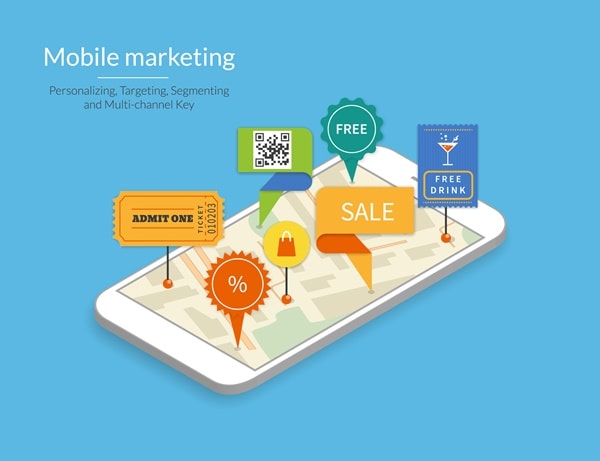Article by: Asst. Prof. Suwan Juntiwasarakij, Ph.D., MEGA Tech Senior Editor
การผสมผสานองค์ประกอบแบบกายภาพหรือองค์ประกอบเชิงมนุษย์เข้ากับการสร้างปฏิสัมพันธ์ทางดิจิทัล จะกลายเป็นเครื่องมือศักยภาพสูงเมื่อนำไปใช้ในการเพิ่มพูนประสบการณ์ของลูกค้า โดยเฉพาะอย่างยิ่งในกลุ่มสินค้าหรือบริการที่ผู้บริโภคจำเป็นต้องศึกษาการใช้งาน ได้รับคำแนะนำ หรือมีการปรับแต่งสินค้าก่อนใช้งาน ตัวอย่างเช่น ในกลุ่มการเงินซึ่งมักพบปัญหาเมื่อทำการซื้อขายผลิตภัณฑ์การเงินแบบออนไลน์หรือการสร้างความสัมพันธ์กับลูกค้า การออกแบบประสบการณ์ลูกค้าแบบไร้แรงเสียดทานนั้น ต้องคำนึงถึง Pain Point ณ จุดที่ลูกค้ากำลังเผชิญอยู่แล้วจะเริ่มมองเห็นหนทางในการปรับปรุงแก้ไขปัญหาดังกล่าว ตัวอย่างเช่น ระยะเวลาการรอคอยหรือการตอบสนองการให้บริการ อีกหนึ่งจุดที่ทำให้ลูกค้าสับสนและไม่พอใจเป็นอย่างมาก
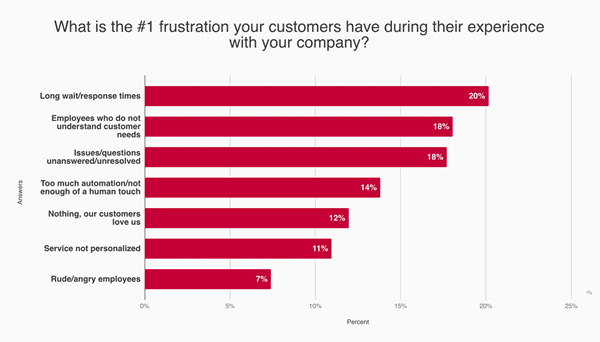
Source: State of Customer Experience 2019, HotJar.com
WAIT TIME IS FRICTION TIME
เสียงตอบรับของลูกค้ามีความสำคัญในทุกที่ที่บริษัทมีปฏิสัมพันธ์กับลูกค้าในงานลูกค้าสัมพันธ์หรืองานบริการเกี่ยวกับสินค้าหรือบริการ ส่วนใหญ่แล้วเกือบครึ่งหนี่งลูกค้าจะอดทนรอคอยเพื่อรับบริการหากใช้เวลาไม่เกิน 1 – 3 นาที ขณะที่ 1 ในสามของลูกค้าจะรอถึง 5 นาที และมีเพียง 10% เท่านั้นที่จะรอมากกว่า 5 นาที
อย่างไรก็ตามผู้บริโภคทั่วโลกถึง 45% ที่สามารถเพิ่มได้ 2 – 5 นาทีหากเป็นสายของเจ้าหน้าที่มีความรู้ความสามารถในการให้บริการ ความอดทดต่อการรอคอยการตอบสนองของลูกค้าลดลงเรื่อย จะเห็นได้ว่าทั้งประสบการณ์ของลูกค้าค้าที่มีต่อแบรนด์และชื่อเสียงของแบรนด์เองกำลังตกอยู่ในที่นั่งลำบากทุกครั้งที่ปล่อยให้ลูกค้ารอรับการบริการ
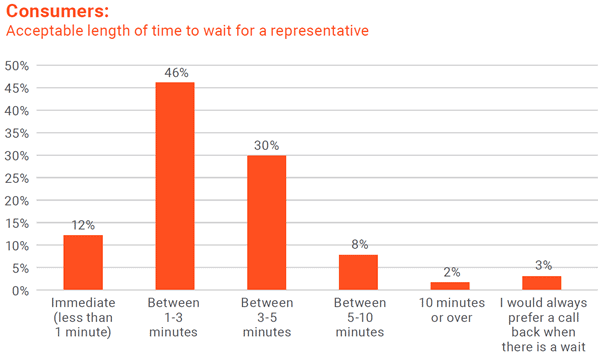
Source: State of Customer Experience research, Genesys
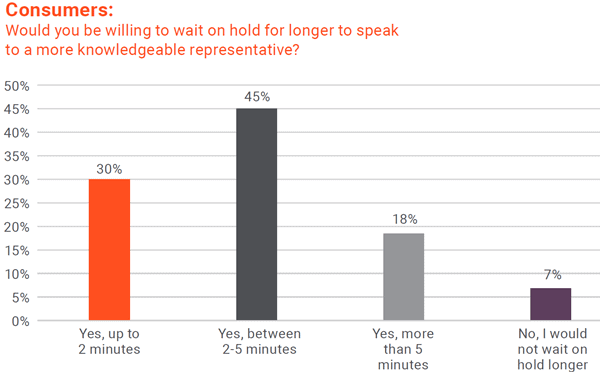
Source: State of Customer Experience research, Genesys
MOBILE IS LESS FRICTION
โมบายช็อปปิ้งเป็นอีกช่องทางหนึ่งที่สามารถเพิ่มขีดความพึงพอต่อประสบการณ์ลูกค้าได้ ซึ่งเริ่มได้รับความนิยมมากขึ้นเนื่องจากได้กำจัดอุปสรรค์ที่ส่งผลลบต่อการสร้างสัมพันธ์กับลูกค้า การมีโต๊ะประชาสัมพันธ์ในร้านค้าทั่วไปอาจจะดูเหมือนเป็นสิ่งที่สร้างโอกาสในการสานสัมพันธ์กับลูกค้า ในความจริงแล้วอาจเป็นจุดที่ชะลอหรือส่งผลเสียต่อกระบวนการสร้างปฏิสัมพันธ์กับลูกค้าก็เป็นได้
ในทางตรงกันข้าม โมบายช็อปปิ้งนั้นไม่มีอุปสรรคเหมือนกับร้านค้าจริง ลูกค้าไม่ต้องเผชิญกับอุปสรรค์ในการหาที่จอดรถ ไม่ต้องพบกับแถวรอคอยเพื่อชำระสินค้าที่ยาวและนาน หรือแม้ก็กระทั่งไม่ต้องพบเจอกับเจ้าหน้าที่แผนก (ไม่) ต้อนรับลูกค้า เหล่านี้เองที่ทำให้โมบายช็อปปิ้งสร้างเสริมประสบการณ์ลูกค้าที่ดีอันนำไปสู่ความพึงพอและสัมพันธ์ภาพที่ดีระหว่างลูกค้าและแบรนด์
รายงานการศึกษาจาก Genesys พบว่า ลูกค้าถึง 78% เลือกที่ใช้อุปกรณ์โมบายในการติอต่อขอรับบริการและเป็นลูกค้าเจนวายถึง 90% นี่คือการก้าวเข้าสู่โมบายอย่างไม่ต้องสงสัย ลูกค้าเจนวายนิยมใช้สมาร์ตโฟนในการเข้าถึงการบริการลูกค้า ส่วนลูกค้าที่อายุ 55 ขั้นไปยังคงชื่นชอบการติดต่อเพื่อรับการบริการผ่านโทรศัพท์บ้าน ประชากรทั่วโลกต่างใช้อุปกรณ์สื่อสารเคลื่อนที่ เครื่องคอมพิวเตอร์ โน้ตบุ๊ค ในการทำงานชีวิตประจำวัน จึงเป็นสิ่งสำคัญที่จะต้องรู้จักกลุ่มของลูกค้าและลักษณะทางประชากรของผู้บริโภค
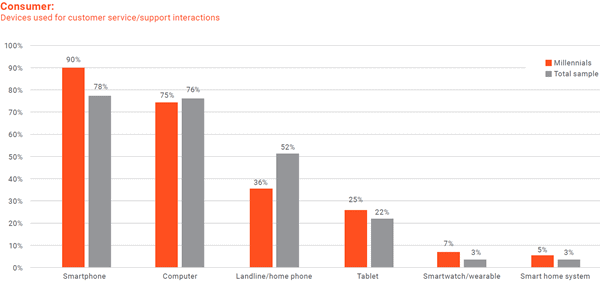
Source: State of Customer Experience research, Genesys
สมาร์ตโฟนเป็นอุปกรณ์ที่ทุกคนคิดถึงเมื่อพูดถึงโมบายช็อปปิ้ง นี่เป็นสาเหตุที่ทำให้โทรศัพท์เคลื่อนที่มีการใช้งานมากกว่าอุปกรณ์อื่นๆ หรือแม้กระทั่งร้านค้าที่อยู่ทั่วไป เมื่อผู้บริโภคคุ้ยเคยและเชื่อใจเทคโนโลยีดิจิทัลเพิ่มมากขึ้น การซื้อสินค้าออนไลน์และบริการต่างๆ ก็จะมากขึ้นตามไปด้วย
ผลการสำรวจผู้บริโภคของ PwC พบว่าในปี 2018 ผู้บริโภคจำนวนถึง 51% ชำระค่าสินค้าบริการช่องทางออนไลน์ ซึ่งจำเป็นจำนวนเดียวกันผู้บริโภคโอนเงินโดยใช้ช่องทางออนไลน์ การเข้าถึงบริการรูปแบบอื่นก็เพิ่มขึ้นไปตามไปด้วย ตัวอย่างเช่นมีผู้บริโภคถึง 54% ที่เลือกชมภาพยนตร์และรายการทีวีแบบสตรีมมิ่งไม่ต่ำกว่าสัปดาห์ละสองครั้ง สำหรับกลุ่มเจนซีนั้นถือว่าเป็นกลุ่มผู้นำเทรดของการเข้าถึงบริการในรูปแบบที่กล่าวมา โดย 52% ของกลุ่มดังกล่าวเข้าถึงบริการสตรีมมิ่งอย่างน้อยหนึ่งครั้งต่อวัน และ 39% ของกลุ่มเดียวกันนี้ที่ใช้โซเชียลมีเดียเพื่อรับชมข่าวและความเคลื่อนไหวทั่วไปเมื่อเทียบกับกลุ่มอายุอื่นที่ใช้โซเชียลมีเดียวในลักษณะเดียวกันเพียง 25%
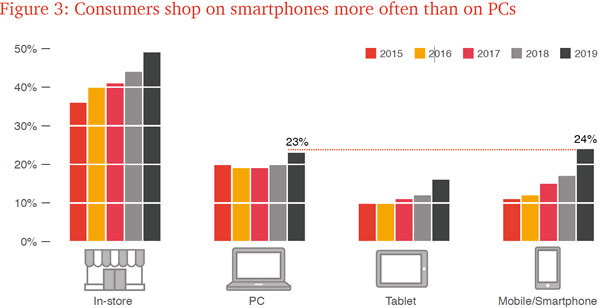
Shopping on physical and digital stores
Source: Global Consumer Insights Survey 2019, PwC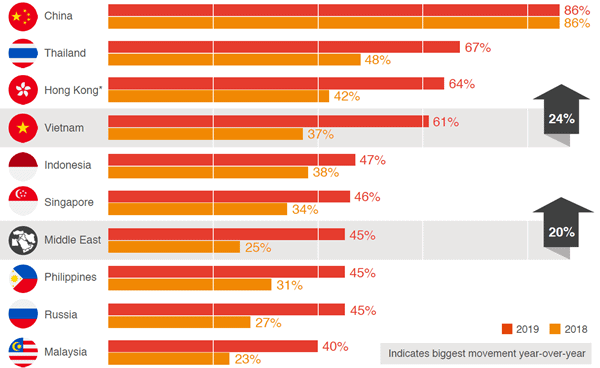
Growth in mobile payment
Source: Global Consumer Insights Survey 2019, PwC
มากไปกว่านั้นบริการชำระเงินด้วยอุปกรณ์สื่อสารเคลื่อนกำลังแผ่ขยายความนิยมไปอย่ากว้างขวางโดย ในบางพื้นที่ถึงกับก้าวกระโดดจากการใช้ระบบโทรศัพท์สายดินไปสู่การใช้สมาร์ตโฟนเลยก็มี เวียดนามเป็นตัวอย่างประเทศที่จำนวนผู้เลือกใช้บริการชำระเงินด้วยอุปกรณ์เพิ่มขึ้นเป็น 61% ภายในปีเดียว ซึ่งสูงขึ้นจากปีก่อนถึง 24% ส่วนตัวเลขในตะวันออกกลางปีนี้อยู่ที่ 45% เพิ่มขึ้น 20 จุดจากปีก่อน ส่วนตัวเลขรวมของทั้งโลกอยู่ที่ 34% สูงขึ้นจากปีก่อน 24%
TAKE-HOME MESSAGE
ให้พึงระลึกอยู่เสมอว่า “เมื่อใดก็ตามที่ผู้บริโภคมีทางเลือก ประสบการณ์ของผู้บริโภคเป็นตัวชี้ขาดว่าใครจะอยู่หรือใครจะไป” ประสบการณ์ผู้บริโภคนี้จะมีคุณค่าหรือประโยชน์มาเพียงใดขึ้นอยู่กับชนิดของอุตสาหกรรม หน่วยงานภาครัฐอาจได้รับผลกระทบน้อยเพราะไม่มีการแข่งขัน แต่สำหรับธุรกิจในอุตสาหกรรมการบริการให้ทำใจได้เลยว่าการแข่งขันดุเดือดแน่นอน หากต้องการออกการปฏิสัมพันธ์กับลูกค้าแบบไร้แรงเสียดท่านและเสริมสร้างประสบการณ์ลูกค้า สิ่งที่ขาดไม่ได้เลยคือการเข้าใจความต้องการเบื้องลึกและความคาดหวังของลูกค้าอย่างแท้จริง และที่สำคัญที่สุดคือภาพลักษณ์ความประทับใจของลูกค้าที่เกิดขึ้นทุกครั้งที่มีการติดต่อรับบริการกับบริษัท

